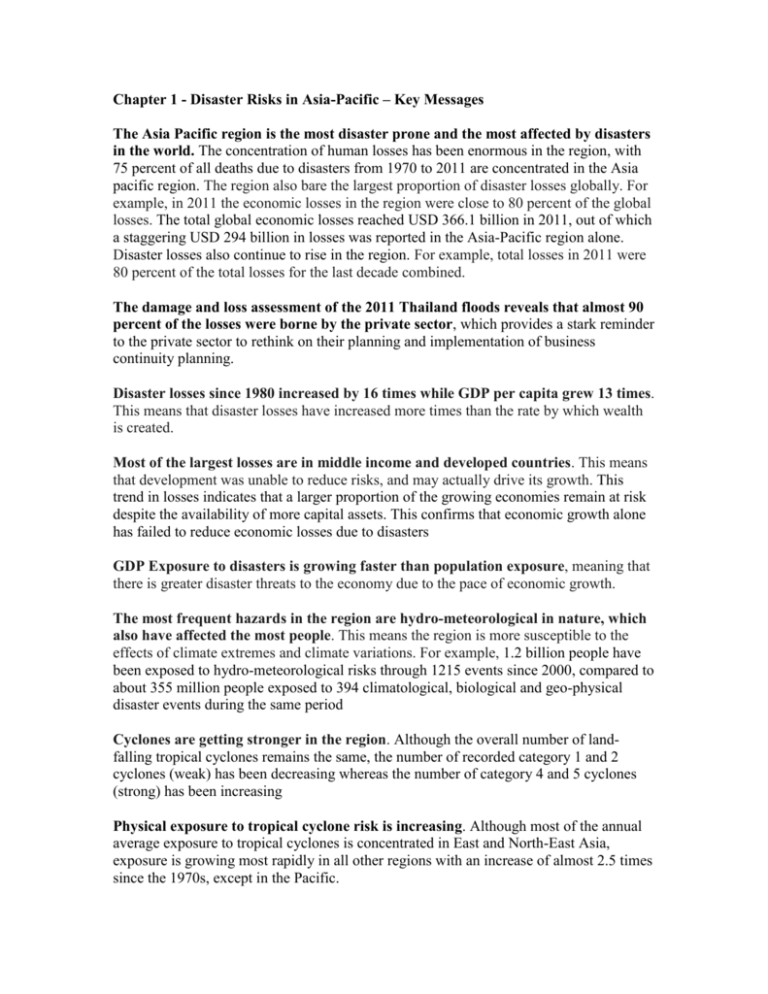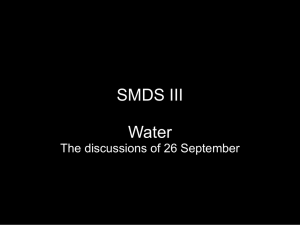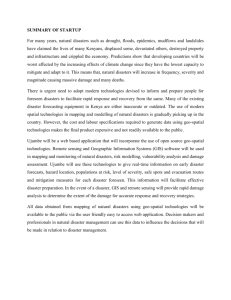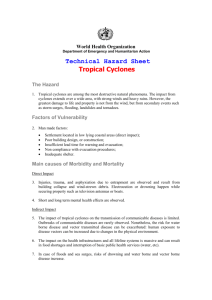Chapter 1 – Key Messages
advertisement

Chapter 1 - Disaster Risks in Asia-Pacific – Key Messages The Asia Pacific region is the most disaster prone and the most affected by disasters in the world. The concentration of human losses has been enormous in the region, with 75 percent of all deaths due to disasters from 1970 to 2011 are concentrated in the Asia pacific region. The region also bare the largest proportion of disaster losses globally. For example, in 2011 the economic losses in the region were close to 80 percent of the global losses. The total global economic losses reached USD 366.1 billion in 2011, out of which a staggering USD 294 billion in losses was reported in the Asia-Pacific region alone. Disaster losses also continue to rise in the region. For example, total losses in 2011 were 80 percent of the total losses for the last decade combined. The damage and loss assessment of the 2011 Thailand floods reveals that almost 90 percent of the losses were borne by the private sector, which provides a stark reminder to the private sector to rethink on their planning and implementation of business continuity planning. Disaster losses since 1980 increased by 16 times while GDP per capita grew 13 times. This means that disaster losses have increased more times than the rate by which wealth is created. Most of the largest losses are in middle income and developed countries. This means that development was unable to reduce risks, and may actually drive its growth. This trend in losses indicates that a larger proportion of the growing economies remain at risk despite the availability of more capital assets. This confirms that economic growth alone has failed to reduce economic losses due to disasters GDP Exposure to disasters is growing faster than population exposure, meaning that there is greater disaster threats to the economy due to the pace of economic growth. The most frequent hazards in the region are hydro-meteorological in nature, which also have affected the most people. This means the region is more susceptible to the effects of climate extremes and climate variations. For example, 1.2 billion people have been exposed to hydro-meteorological risks through 1215 events since 2000, compared to about 355 million people exposed to 394 climatological, biological and geo-physical disaster events during the same period Cyclones are getting stronger in the region. Although the overall number of landfalling tropical cyclones remains the same, the number of recorded category 1 and 2 cyclones (weak) has been decreasing whereas the number of category 4 and 5 cyclones (strong) has been increasing Physical exposure to tropical cyclone risk is increasing. Although most of the annual average exposure to tropical cyclones is concentrated in East and North-East Asia, exposure is growing most rapidly in all other regions with an increase of almost 2.5 times since the 1970s, except in the Pacific. Human exposure to hydro-meteorological hazards still continues to rise. Population almost doubled from 2.2 billion to 4.2 billion people between 1970 and 2010, and the average number of people exposed to yearly flooding more than doubled from 29.5 to 63.8 million. In addition, the population resident in cyclone-prone areas grew from 71.8 million to 120.7 million. Despite the increase in exposure, for hydro-meteorological hazards, mortality risks are decreasing for some subregions. This can be attributed to improved development conditions and shows the impact of investments in early warning, preparedness. Economic exposure to hydro-meteorological hazards is increasing dramatically in all the sub-regions of Asia-Pacific. The main driver of economic risks due to hydrometeorological hazards is exposure. Global GDP has more than tripled from 12.4 to 40.2 trillion dollars (in constant 2000 USD). The Asia-Pacific GDP has grown by four and a half times during the same period. Trends in economic exposure are increasing for nearly all sub-regions and for all hazards. The Asia-Pacific region represents more than 85 per cent of global economic exposure to tropical cyclones. Economic exposure to floods in East and North-East Asia increased ten-fold in 40 years. East and North-East Asia represents 85 per cent of global economic exposure to rain-triggered landslides Some sub-regions are extremely economically exposed to hydro-meteorological hazards. For example, in North East Asia, flood economic exposure has grown 10 fold. This maybe because most new development have been in coastlines and flood plains, that have easy access to port, clean source and available water, and other services. Deaths continue to rise for small and medium scale disasters. Despite in a global trend of a decrease in number of deaths due to disasters particularly those caused by hydro meteorological hazards, for small and medium scale disasters, deaths continue to rise. For low capacity countries, small and medium scale disasters are equally destructive compared to large-scale disasters. In particular, in low capacity countries like Nepal, the number of deaths and the damage to housing due to small scale but frequent disasters is similar to those from large scale but rare disasters. This means the developmental benefit seen in other countries from early warning and preparedness is not as evident in areas with low capacities. For urban settlements in developing countries, the exposure and vulnerability to hydro-meteorological hazards are increasing. For examples, out of 305 urban agglomerations in the Asia Pacific region, 119 are in the coastal areas. The main urban agglomerations with high concentration of population mostly overlap with the extreme or high mortality risk areas. The population of people living in urban areas in Asia has gone up from 17 percent of the total population in 1950 to 44 percent in 2010, and will likely reach 64 percent of Asia’s total population by 2050. Urban growth increases disaster risks. The type of growth, for example in terms of urbanization, affects the spread of incidence of fire disasters, although the total number of such disasters maybe decreasing. This means although there are benefits that urban life brings in terms of various services, the type of growth - in this case, urban housing design and construction, or location and development of low income housing, often creates vulnerabilities or exposure to disasters. Disasters are dynamic and need to be constantly re-evaluated. The growing nature of economic losses, the realization of unexpected sequential events like the Japan earthquake, tsunami and nuclear disaster, and the nature of the main driver of risks, which is exposure, highlight the need to constantly revisit the understanding of risks in the region.





